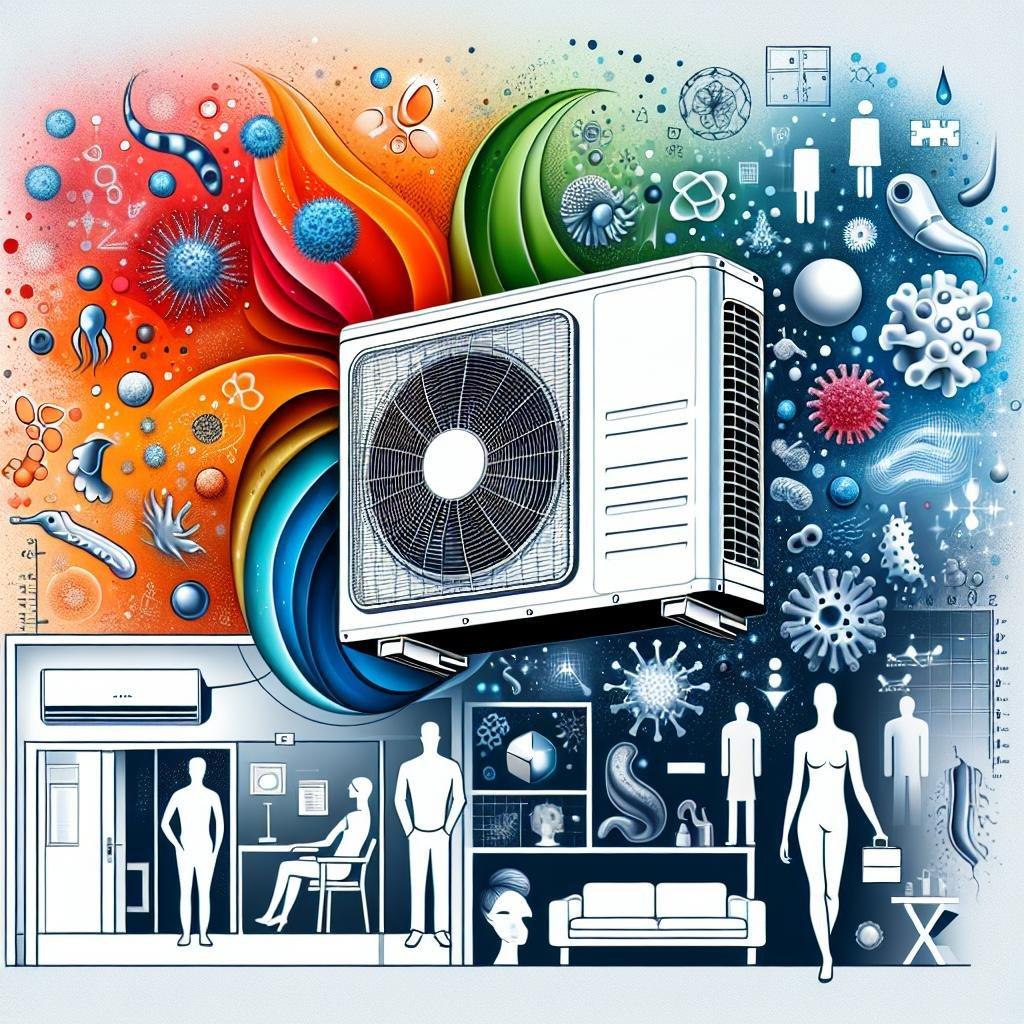In today’s world, where our understanding of health and wellness is continually evolving, the quality of the air we breathe—especially in commercial spaces—has taken on newfound importance. A hidden yet crucial aspect of environmental health, air quality directly impacts employee productivity, client comfort, and overall business success. One often-overlooked component in this equation is the mini-split air conditioning system, wich, while efficient and effective, can, if not properly evaluated, contribute to circulating pollutants and allergens. This article aims to guide you through the essential steps on how to assess the air quality in a commercial space equipped with a mini-split AC system. From understanding the importance of clean air to recognizing key indicators of air quality, we’ll explore practical methods and best practices that can help ensure your work environment remains a breath of fresh air.
Understanding Indoor Air Quality Indicators in Commercial Spaces
when evaluating air quality in commercial spaces, several key indicators serve as benchmarks for a healthy environment. Particulate Matter (PM) levels are crucial to monitor, as they can stem from construction activities, dust, and even the operation of HVAC systems like mini split acs. Additionally, measuring Carbon Dioxide (CO2) concentrations provides insight into occupancy levels and ventilation efficiency. High CO2 levels may indicate inadequate fresh air circulation, impacting employee comfort and productivity. Other factors to consider include Volatile Organic Compounds (VOCs),frequently enough emitted from paint,cleaning products,and office equipment,and Humidity Levels,which should ideally be maintained between 30% and 50% to prevent mold growth and promote a cozy atmosphere.
Utilizing appropriate measurement tools is essential for accurate assessment of these indicators. To streamline this process, consider employing digital monitors that can provide real-time readings of air quality parameters. Some of the effective indicators include:
- Temperature: Target range of 68-72°F for comfort.
- Humidity: Aim for 30%-50% to reduce mold growth.
- CO2 Levels: Keep below 1,000 ppm for optimum air quality.
- PM Levels: Monitor to keep under 12 µg/m³.
- VOCs: Maintain levels as low as possible for safety.
Incorporating a systematic approach to monitor these crucial air quality indicators not only enhances the overall environment but also ensures regulatory compliance and employee well-being.

Assessing the Role of Mini Split AC Systems in Air quality Control
Mini split AC systems not only provide efficient cooling but also play a crucial role in maintaining indoor air quality. Unlike traditional HVAC systems, which frequently enough recycle indoor air, mini splits can incorporate both fresh air intake and filtration, substantially improving air circulation.This enhanced airflow helps mitigate common contaminants such as dust, mold spores, and pollen, creating a healthier environment in commercial spaces. Additionally,the ability to control the temperature of individual zones allows businesses to create tailored environments that cater to the varying needs of occupants and activities.
Integrating advanced filtration options with mini split AC systems can further elevate air quality management. Manny models come equipped with multi-stage filters designed to trap smaller particles and contaminants, including volatile organic compounds (VOCs) and pet dander. To assess the effectiveness of any mini split system in a commercial setting,consider the following factors:
- Filter Type: Check for HEPA or activated carbon filters.
- Air Exchange Rate: Measure the frequency of air replacement.
- Maintenance Schedule: Regular filter changes and system check-ups.
| Factor | Impact on Air Quality |
|---|---|
| Filter efficiency | Traps more harmful particles. |
| System Placement | Optimizes airflow throughout the space. |
| Humidity Control | Reduces mold growth and improves comfort. |

Practical Steps for Monitoring Pollutants and Ventilation Efficiency
To ensure a healthy indoor environment, it’s crucial to implement . Start by conducting regular assessments using air quality sensors that detect common indoor pollutants, such as volatile organic compounds (VOCs), carbon dioxide (CO2), and particulate matter (PM2.5).By placing these devices strategically throughout the space, you can gather real-time data, allowing for immediate adjustments in both ventilation and purification. Additionally,consider employing smart ventilation systems that automatically adjust airflow based on pollutant levels,ensuring optimal air quality without requiring constant manual oversight.
Another essential measure is ensuring that your mini-split AC units are properly maintained and optimized for air circulation. Regularly inspect and replace filters, and check for any blockages in the air ducts to enhance airflow efficiency. You can also conduct periodic ventilation assessments to verify that fresh air is consistently entering the space. Utilize the table below to summarize various pollutants and their sources, alongside their potential health effects:
| Pollutant | Source | Health Effects |
|---|---|---|
| Carbon Dioxide (CO2) | Occupants, combustion appliances | dizziness, headaches |
| Volatile Organic Compounds (VOCs) | Paints, cleaning products | Nausea, throat irritation |
| Particulate matter (PM2.5) | Dust, smoke, vehicle emissions | Respiratory issues, cardiovascular problems |

Implementing effective Solutions for Enhanced Air Quality Management
Understanding and evaluating air quality in commercial spaces equipped with mini split AC systems is crucial for maintaining both employee health and workplace productivity. To begin the evaluation process, consider assessing various aspects that can influence air quality:
- Ventilation: Check the efficiency of the mini split AC in circulating fresh air and removing pollutants.
- Humidity Levels: Monitor humidity; excessive moisture can lead to mold growth and other airborne irritants.
- Particulate Matter: Utilize air quality monitors to detect levels of dust, pollen, and other particles.
- odor Assessment: Identify any unpleasant smells that may indicate air quality issues or contamination.
After gathering data, it is essential to analyze it effectively. Create a complete air quality report containing critical findings and actions needed to address any deficiencies. Use a simple table to outline the evaluation metrics and corresponding recommendations:
| Metric | Current Status | Recommended Action |
|---|---|---|
| CO2 Levels | High | Increase ventilation or add additional air purifiers |
| Humidity | Moderate | Use dehumidifiers regularly |
| Particulate Matter | Moderate | Regular filter changes and air quality monitoring |
Implementing these strategies not only improves air quality but also fosters a healthier work environment, leading to greater employee satisfaction and performance.
Q&A
Q&A: How to Evaluate the Air Quality in a Commercial Space with Mini Split AC
Q1: What is a mini split AC system, and how does it impact air quality in commercial spaces?
A1: A mini split AC system is a type of ductless air conditioning unit that consists of an outdoor compressor and one or more indoor air handling units. Unlike traditional HVAC systems, mini splits offer individualized temperature control for different areas. This capability can enhance air quality by enabling better ventilation, precise temperature regulation, and effective humidity control—factors that significantly contribute to the overall comfort and healthiness of the air in commercial environments.
Q2: Why is it vital to evaluate air quality in commercial spaces?
A2: Evaluating air quality in commercial spaces is crucial for ensuring the health and productivity of employees and visitors.Poor air quality can lead to various health issues, including respiratory problems, headaches, and fatigue. moreover, a comfortable working environment directly affects productivity. By assessing air quality, businesses can identify potential issues—such as pollutants or inadequate ventilation—and take corrective measures to create a healthier space.
Q3: What are the key indicators of air quality that should be monitored?
A3: The key indicators of air quality include:
- Level of Volatile Organic Compounds (VOCs): These are harmful gases emitted by various solids and liquids, like paints, varnishes, and cleaning products.
- Carbon Dioxide (CO2) Levels: Elevated CO2 can lead to drowsiness and reduced cognitive function, frequently enough resulting from inadequate ventilation.
- Particulate Matter (PM): This includes dust, allergens, and other microscopic particles that can be harmful when inhaled.
- Humidity Levels: High or low humidity can influence comfort and mold growth, affecting overall air quality.
- Temperature variations: An uncomfortable temperature can lead to increased complaints and decreased productivity.
Q4: how can business owners assess these indicators in spaces with mini split AC systems?
A4: Business owners can assess air quality by utilizing several methods:
- Digital Air Quality Monitors: These devices can track VOCs, CO2 levels, PM, humidity, and temperature in real time, providing valuable data for analysis.
- Regular HVAC Maintenance: Scheduled inspections and filter changes for mini split systems ensure optimal performance and reduce airborne pollutants.
- air Sampling Kits: These kits can help identify specific contaminants in the air, especially useful for VOC assessment.
- Employee Feedback Surveys: Collecting feedback from employees can definitely help assess perceived air quality and comfort, revealing practical insights into areas needing advancement.
Q5: What steps can be taken to improve air quality if issues are discovered?
A5: If issues are discovered during your evaluation, consider the following steps to improve air quality:
- Increase Ventilation: Open windows when possible or use exhaust fans to enhance air circulation.
- Upgrade Filters: Utilize high-efficiency particulate air (HEPA) filters in your mini split system to capture more airborne particles.
- Invest in Air Purifiers: Portable air purifiers can definitely help eliminate pollutants and improve the air quality in specific areas.
- Control Humidity Levels: Use dehumidifiers in damp areas and ensure that your mini split system is set to maintain an optimal humidity level.
- Educate Employees: Provide data on how employees can contribute to better air quality—for example, minimizing the use of chemical cleaning products or smoking near entry points.
Q6: How frequently should air quality evaluations be conducted in commercial spaces?
A6: Ideally, air quality evaluations should be conducted at least twice a year, though businesses with higher foot traffic or specific environmental concerns may benefit from quarterly assessments. Regular evaluations enable timely identification of issues and the implementation of necessary adjustments to maintain a healthy indoor environment.
Q7: Can assessing air quality help in compliance with regulations or certifications?
A7: Absolutely. Many commercial spaces are required to comply with local and national air quality regulations. Regular assessments can definitely help ensure adherence to these standards, reducing legal risks and promoting a commitment to environmental health. Additionally, businesses aiming for certifications—such as LEED—can bolster their case by proving proactive measures in air quality management.
By systematically evaluating the air quality in commercial spaces with mini split AC systems, owners can cultivate healthier environments that benefit everyone—from staff to customers.
Closing Remarks
assessing the air quality in a commercial space equipped with mini split AC units is not just a matter of comfort; it’s a cornerstone of health and productivity. By leveraging the right tools and practices—such as monitoring pollutants, maintaining proper humidity levels, and regularly servicing your AC systems—you can cultivate an environment that promotes well-being for both employees and customers alike.
As we’ve explored, the nuances of air quality assessment can be complex, yet the steps you take today can lead to notable improvements in indoor air robustness tomorrow. Armed with knowledge and diligence, you can transform your commercial space into a sanctuary of fresh air, helping to breathe life into your business. Remember, the air we share deserves our attention—let’s make every breath count.

